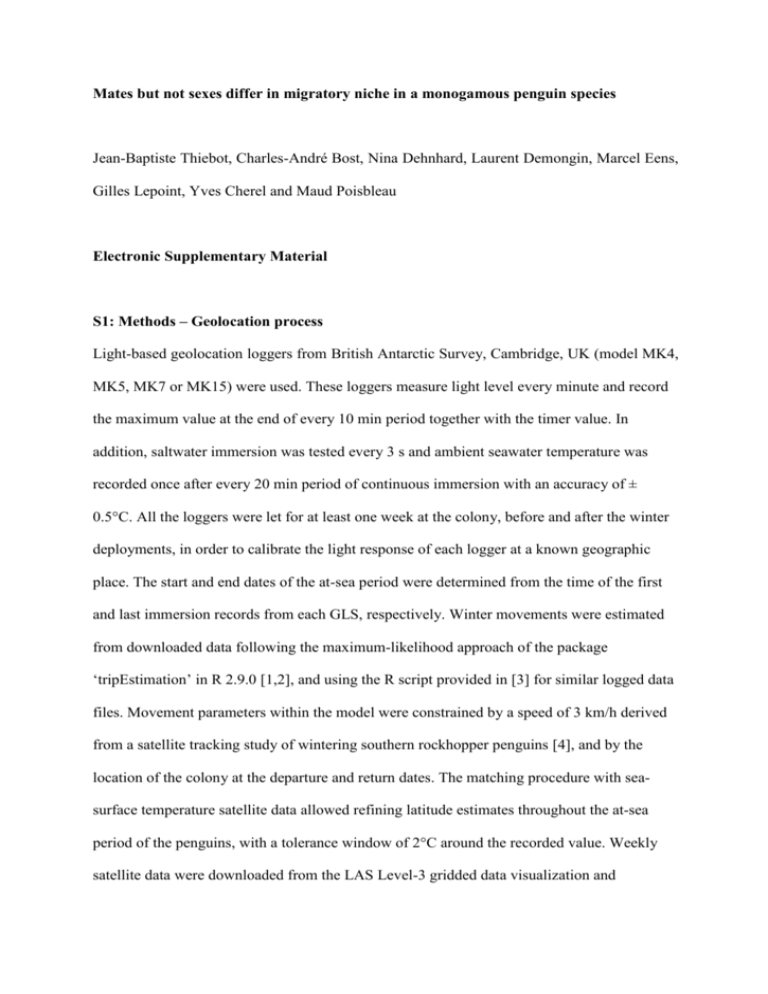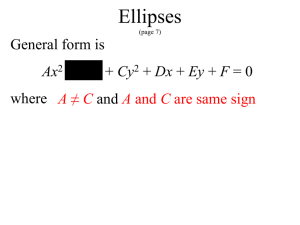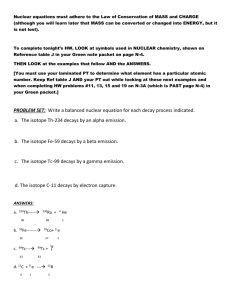Mates but not sexes differ in migratory niche in a monogamous
advertisement

Mates but not sexes differ in migratory niche in a monogamous penguin species Jean-Baptiste Thiebot, Charles-André Bost, Nina Dehnhard, Laurent Demongin, Marcel Eens, Gilles Lepoint, Yves Cherel and Maud Poisbleau Electronic Supplementary Material S1: Methods – Geolocation process Light-based geolocation loggers from British Antarctic Survey, Cambridge, UK (model MK4, MK5, MK7 or MK15) were used. These loggers measure light level every minute and record the maximum value at the end of every 10 min period together with the timer value. In addition, saltwater immersion was tested every 3 s and ambient seawater temperature was recorded once after every 20 min period of continuous immersion with an accuracy of ± 0.5°C. All the loggers were let for at least one week at the colony, before and after the winter deployments, in order to calibrate the light response of each logger at a known geographic place. The start and end dates of the at-sea period were determined from the time of the first and last immersion records from each GLS, respectively. Winter movements were estimated from downloaded data following the maximum-likelihood approach of the package ‘tripEstimation’ in R 2.9.0 [1,2], and using the R script provided in [3] for similar logged data files. Movement parameters within the model were constrained by a speed of 3 km/h derived from a satellite tracking study of wintering southern rockhopper penguins [4], and by the location of the colony at the departure and return dates. The matching procedure with seasurface temperature satellite data allowed refining latitude estimates throughout the at-sea period of the penguins, with a tolerance window of 2°C around the recorded value. Weekly satellite data were downloaded from the LAS Level-3 gridded data visualization and subsetting tool (http://podaac-tools.jpl.nasa.gov/las), with a spatial resolution of 1°. The use of a “land mask” precluded any location estimate to occur on land for our marine study species. Thanks to this geolocation approach, no location estimate was discarded for the analyses, although the at-sea period of penguins (April–October) included the equinox periods when the calculation of latitude based on light and time only is unreliable for 2–3 weeks (because day length is equivalent everywhere on Earth at that time). References: 1. R Development Core Team 2009 R: a language and environment for statistical computing. Vienna, Austria: R Foundation for Statistical Computing (http://www.Rproject.org). 2. Sumner MD, Wotherspoon SJ, Hindell MA. 2009 Bayesian estimation of animal movement from archival and satellite tags. PLoS ONE 4, e7324. 3. Thiebot JB, Pinaud D. 2010 Quantitative method to estimate species habitat use from light-based geolocation data. Endang. Species Res. 10: 341–343. 4. Raya Rey A, Trathan P, Pütz K, Schiavini A. 2007 Effect of oceanographic conditions on the winter movements of rockhopper penguins Eudyptes chrysocome chrysocome from Staten Island, Argentina. Mar. Ecol. Prog. Ser. 330, 285–295. S2: Methods – Stable isotope analyses Blood samples (1 ml) were taken from the brachial vein within 3 min after capture (heparinised syringe, 23-gauge needle). After centrifugation, plasma was removed and red blood cell samples were frozen (-20°C) and later dried in a drying furnace (60°C). Dried red blood cells were homogenised and ground to a fine powder. Stable isotope ratio of carbon and nitrogen were measured on 0.8 mg aliquots, weighed into tin cups in continuous flow by mass spectrometry (Isoprime 100, Isoprime, UK) coupled to an elemental analyser (Vario Microcube, Elementar, Germany). Stable isotope ratios were expressed in δ notation as parts per thousand (‰) deviation from the international standards Vienna Pee Dee Belemnite (carbon) and AIR (nitrogen), according to, δX= [(RSample-RStandard)/RStandard]*1000 where X is 15N or 13C and R is the corresponding ratio 15N/14N or 13C/12C. Pure gasses of CO2 and N2 were used and calibrated against certified reference materials, i.e. sucrose (IAEA-C6; δ13C=−10.8±0.5‰), ammonium sulfate (IAEA-N2; δ15N=+20.3±0.2‰). The analysis' performance was assessed by procedural blanks, replicated samples and in-house standard (i.e. glycine). Analytical precision (±S.D.) on replicated samples equaled ± 0.3 and ± 0.5‰ for δ13C and δ15N, respectively. S3: Results – Stable Isotope Bayesian Ellipses in R (SIBER) Isotopic niche metrics of male and female southern rockhopper penguins from New Island were calculated with the SIAR package in R 3.2.0 [1]. This Bayesian approach fits a standard ellipse to bivariate data analytically using maximum likelihood estimators. The standard ellipse area represents the core isotope niche width as described by [2]. Metric Description Males Females SEA The area of the standard ellipse 1.22 0.63 SEAc The area of the small sample size corrected 1.38 0.71 standard ellipse overlap The area of overlap between the two sample size 0.30 corrected standard ellipses theta The angle of the semi-major axis of the ellipse 1.15 1.08 with the x-axis eccentricity Eccentricity of the ellipse 0.992 0.996 a The length of the semi-major axis a 1.78 1.54 b The length of the semi-minor axis b 0.22 0.13 ac The length of the semi-major axis a based on the 1.89 1.63 0.23 0.14 small sample size correction bc The length of the semi-minor axis b based on the small sample size correction References: 1. R Development Core Team 2015 R: a language and environment for statistical computing. Vienna, Austria: R Foundation for Statistical Computing (http://www.Rproject.org). 2. Jackson AL, Inger R, Parnell AC, Bearhop S. 2011 Comparing isotopic niche widths among and within communities: SIBER – stable isotope Bayesian ellipses in R. J. Anim. Ecol. 80, 595–602.








